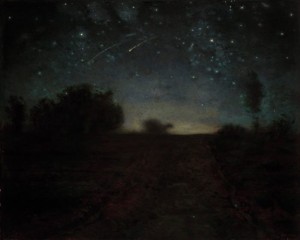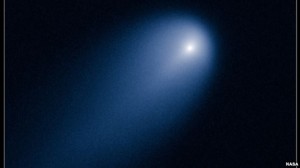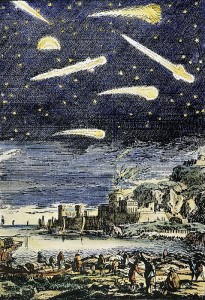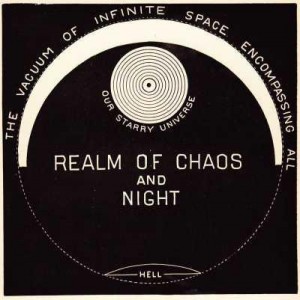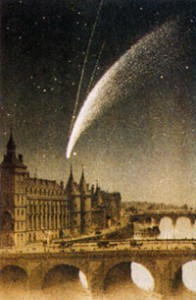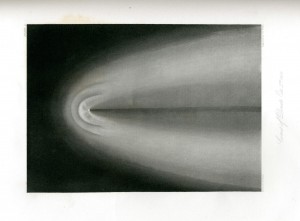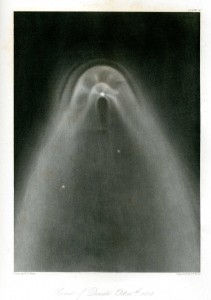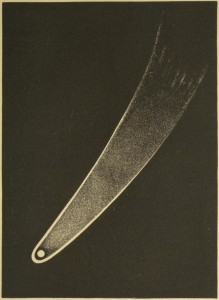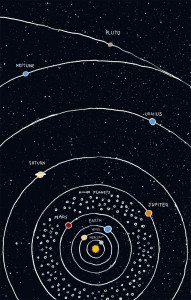From Stephen Ellcock‘s fabulous Facebook archive.
Astronomy
Comet ISON Update
David Eicher, editor of Astronomy magazine, gives this clear-eyed update on Comet ISON, the latest “Comet of the Century.”
His prognosis: It’s still too early to tell exactly how spectacular Comet ISON will be, but rest assured that it’ll be bright, a “naked-eye comet from mid-November through year’s end.”
Here’s a nice view of Comet ISON from the Hubble telescope, April 10, 2013:
Comets in Description de l’Universe
Illustration of different types of comets in Alain Manesson Mallet’s Description de l’Universe (Paris, 1683). You can see the whole text, full of fabulous maps, online here.
Camille Flammarion’s Telephonoscope
I’d like one of these, a “Telephonoscope.” As described in Camille Flammarion’s 1894 novel “La Fin du Monde” (The End of the World). Flammarion is known as one of the fathers of science fiction, an “astronomer, mystic and storyteller” who was “obsessed by life after death, and on other worlds, and seemed to see no … Read more
Maria Mitchell’s 195th Birthday on Google
Check out Google’s homepage today. That’s Maria Mitchell, the first professional female American astronomer. The comet she discovered in 1847 (by spying from her roof?) became known as “Miss Mitchell’s Comet.” King Frederick of Denmark awarded her a medal for her achievements; the medal read, “Not in vain do we watch the setting and rising … Read more
Advocate Editorial
Nice surprise this morning to find my new novel mentioned by the editors of the Baton Rouge/New Orleans Advocate newspaper. Thanks, Advocate.
Our Views: Louisiana’s night skies
Just in time for the summer reading season, New Orleans novelist George Bishop’s new book, “The Night of the Comet,” offers a nice reminder of what it was like to look at the night sky before light pollution made star-gazing so difficult in many cities.
Bishop’s novel, set in the fictional Louisiana town of Terrebonne in 1973, uses the arrival of the Comet Kohoutek as the backdrop for a family story that’s about many things, including the connection between fathers and sons.
At its heart is 14-year-old Alan Broussard Jr., who gets a telescope for his birthday. The novel opens in Baton Rouge in 2000, as Alan does some stargazing near Perkins Road and thinks back to his times with his father.
Light pollution from street lamps and homes makes the night sky more difficult to see.
We hope that the night sky becomes more visible in communities across south Louisiana.
In the meantime, Bishop’s novel is a testament to what we’re missing.
*30*
Copyright © 2011, Capital City Press LLC • 7290 Bluebonnet Blvd., Baton Rouge, LA 70810 • All Rights Reserved
Realm of Chaos and Night
Diagram of Milton’s Cosmology from Homer Sprague’s 1883 edition of John Milton’s “Paradise Lost”:
“Such place eternal justice has prepared
For those rebellious; here their prison ordained
In utter darkness, and their portion set
As far removed from God and light of heaven
As from the centre thrice to the utmost pole.
Oh, how unlike the place from whence they fell!” (p16/7).
From Unurthed.com
Donati’s Comet of 1858
No. 7 in our weekly comet profile is Donati’s Comet. After the Great Comet of 1811, Donati’s is known as the most brilliant comet of the 19th century. I posted one image of Donati’s Comet already, on May 1, but here she is again, seen above Paris in October 1858:
Donati’s Comet was famous for its shroud-like coma. For one stretch of three weeks, the comet expelled a new coma every 4 1/2 hours, like a woman casting off a series of veils.
Here are some more images, from “An Account of Donati’s Comet of 1858” (Cambridge, 1858), by George Bond, who also made the sketches:
Edwin Emerson’s “Comet Lore” (New York, 1910) has this to say about Donati’s Comet:
“This Comet, which appeared to be charging straight down from the zenith, and had a curved tail, was observed from June 1858 to April 1859. It was seen at its brightest in the South, in Italy, Mexico and in the Far East. While it shone over the Far East there were bloody wars between the British and the risen people of India; between the British and the Chinese, who objected to having opium thrust upon them; while Japan was in the throes of revolution and civil war. In Mexico the standard of revolt against the clericals was raised by Juarez, thus plunging Mexico into civil war and war with France. Immediately after the disappearance of the Comet war broke out in Italy between the French and Italians on one side and
the Austrians on the other, ending in the bloody Battle of Solferino.”
A lot to lay on a comet.
Closer to home, Senator Abraham Lincoln observed the comet from the porch of his hotel in Jonesboro, Illinois, as he prepared for a debate against Stephen Douglas–one of the historic Lincoln-Douglas debates over the future of slavery in America, in which Lincoln famously declared “A house divided against itself cannot stand.”
A person of a novelistic bent might imagine that Donati’s Comet helped inspire these words from Lincoln, and thus, in a roundabout way, a comet helped to bring about the end of slavery in the United States.
The Great Comet of 1811, “Napoleon’s Comet”
No. 6 in our Comet a Week is The Great Comet of 1811, also known as Napoleon’s Comet. With a coma over a million miles across, it was visible in the sky for almost a year. The comet was believed to have portended Napoleon’s invasion of Russia and the War of 1812.
The best thing about this comet is that it makes a cameo in Count Leo Tolstoy’s magnificent War and Peace, where it’s called, confusingly, the Comet of 1812.
It appears at the end of Book Eight (in my Kropoktin translation). Pierre has just confessed his love to Natasha. Here’s the passage:
“Where now?” asked the driver.
“Where?” repeated Pierre to himself. “Where can I go now? To the club, or to make some calls?”
All men, at this moment, seemed to him so contemptible, so mean, in comparison with the feeling of emotion and love that overmastered him–in comparison with that softened glance of gratitude which she had given him just now through her tears.
“Home,” said Pierre, throwing back his bearskin cloak over his broad, joyfully throbbing chest, though the mercury marked ten degrees of frost.
It was cold and clear. Above the dirty, half-lighted streets, above the black roofs of the houses, stretched the dark, starry heavens. Only as Pierre gazed at the heavens above, he ceased to feel the humiliating pettiness of everything earthly in comparison with the height to which his soul aspired. As he drove out of Argat Square, the mighty expanse of the dark, starry sky spread out before his eyes. Almost in the zenith of this sky–above the Pretchistensky Boulevard–convoyed and surrounded on every side by stars, but distinguished from all the rest by its nearness to the earth, and by its white light, and by its long, curling tail, stood the tremendous brilliant comet of 1812–the very comet that men thought presaged all manner of woes and the end of the world.
But in Pierre, this brilliant luminary, with its long train of light, awoke no terror. On the contrary, rapturously, his eyes wet with tears, he contemplated this glorious star which seemed to him to have come flying with inconceivable swiftness through measureless space, straight toward the earth, there to strike like an enormous arrow, and remain in that one predestined spot upon the dark sky; and, pausing, raise aloft with monstrous force its curling tail, flashing and sparkling with white light, amid the countless other twinkling stars. It seemed to Pierre that this star was the complete reply to all that was in his soul as it blossomed into new life, filled with tenderness and love.
I think we can all agree that no one writes comets like Tolstoy.
The Minor Planets: Who Knew There Were So Many?
At first I thought this simplified illustration of the solar system was whimsical and interesting, but hardly accurate. That band of “Minor Planets” between Jupiter and Mars–that couldn’t be right, could it?
Ah, but it’s true. Hundreds of thousands of minor planets have been discovered within the solar system and thousands more are discovered each month (from Wikipedia). That band in the diagram is more often referred to as the Asteroid Belt, but asteroids are only one class of minor planets bouncing around the Sun.
There are also Dwarf Planets, Centaurs, Trojans, and Trans-Neptunian Objects like Cubewanos and Plutinos–all “minor planets” in our solar system.
The Minor Planet Center, of the International Astronomical Union, logs the many, many minor planets as they’re discovered, along with comets.
Their Latest Published Data indicates, incredibly, 100,913,328 observed Minor Planets and 658,679 comets.
I haven’t been able to find out who the artist of that illustration is, by the way.
